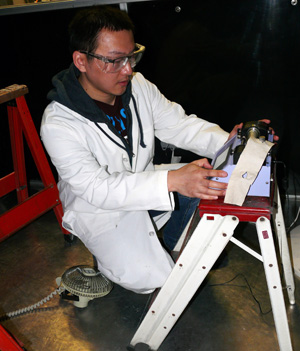MS students in the Occupational Hygiene program must complete a small research project. PhD students conduct larger research projects that produce a dissertation and manuscripts that are submitted for publication to technical journals. Students may conduct research that is laboratory-based or field-based, or some combination of the two.
OCCUPATIONAL HYGIENE LABORATORY
 The Occupational Hygiene Laboratory, shared by the OccHyg core faculty, occupies 2,500 sq. ft. and is equipped with the latest instrumentation for measurement of gases, vapors, particulate matter, biological aerosols, noise, radiation, and hazardous materials. The lab consists of a large room occupied by a walk-in exposure chamber, a wind tunnel, a filter tester, and a biological safety cabinet; a smaller room with benches and two laboratory hoods; a wet-chemistry laboratory with work benches and another lab hood; and several smaller work, storage, and office spaces. For aerosol research and measurements, the OccHyg Lab has condensation particle counters for measuring nanoparticle concentrations, nephelometers for measuring aerosol mass concentrations, diffusion chargers capable of measuring surface area concentrations, instruments for measuring particle size distributions, samplers for collecting biological aerosols, and numerous gravimetric samplers and cascade impactors. To analyze filter samples, microbalances and microscopes are present. The OccHyg Lab also owns equipment for gas and vapor sampling, including direct reading instruments for measuring ammonia and hydrogen sulfide concentrations and concentrations of organic vapors. The lab also has typical occupational hygiene devices such as flow calibrators, sampling and vacuum pumps, Dräger pumps and tubes, noise dosimeters, velometers, manometers, pressure gauges, pitot tubes, and centrifugal fans. Equipment is available for generating different kinds of gases, vapors, and aerosols for experiments.
The Occupational Hygiene Laboratory, shared by the OccHyg core faculty, occupies 2,500 sq. ft. and is equipped with the latest instrumentation for measurement of gases, vapors, particulate matter, biological aerosols, noise, radiation, and hazardous materials. The lab consists of a large room occupied by a walk-in exposure chamber, a wind tunnel, a filter tester, and a biological safety cabinet; a smaller room with benches and two laboratory hoods; a wet-chemistry laboratory with work benches and another lab hood; and several smaller work, storage, and office spaces. For aerosol research and measurements, the OccHyg Lab has condensation particle counters for measuring nanoparticle concentrations, nephelometers for measuring aerosol mass concentrations, diffusion chargers capable of measuring surface area concentrations, instruments for measuring particle size distributions, samplers for collecting biological aerosols, and numerous gravimetric samplers and cascade impactors. To analyze filter samples, microbalances and microscopes are present. The OccHyg Lab also owns equipment for gas and vapor sampling, including direct reading instruments for measuring ammonia and hydrogen sulfide concentrations and concentrations of organic vapors. The lab also has typical occupational hygiene devices such as flow calibrators, sampling and vacuum pumps, Dräger pumps and tubes, noise dosimeters, velometers, manometers, pressure gauges, pitot tubes, and centrifugal fans. Equipment is available for generating different kinds of gases, vapors, and aerosols for experiments.
EXPOSURE SCIENCE AND SUSTAINABILITY INSTITUTE (ESSI)
essi.umn.edu
 The Exposure Science and Sustainability Institute (ESSI) in the University of Minnesota Division of Environmental Health Sciences was founded in 2015 by Dr. Susan Arnold and Dr. Gurumurthy Ramachandran to provide excellence in exposure science and sustainability research and training, responding to industry identified needs.
The Exposure Science and Sustainability Institute (ESSI) in the University of Minnesota Division of Environmental Health Sciences was founded in 2015 by Dr. Susan Arnold and Dr. Gurumurthy Ramachandran to provide excellence in exposure science and sustainability research and training, responding to industry identified needs.
Through ESSI, faculty and students conduct applied research to help industry answer practical questions. They generate the data to support data-driven exposure and risk management decision making, facilitating world-class product stewardship, and conduct training to ensure practicing IH and EHS professionals have the knowledge and skills they need to succeed. Through the use of the state-of-the-art full-size exposure chamber and instruments, they can measure a broad range of chemical agents and exposure scenarios for companies and industry groups, and they also conduct field surveys and assessments, providing companies and communities with exposure assessment information and health risks.




